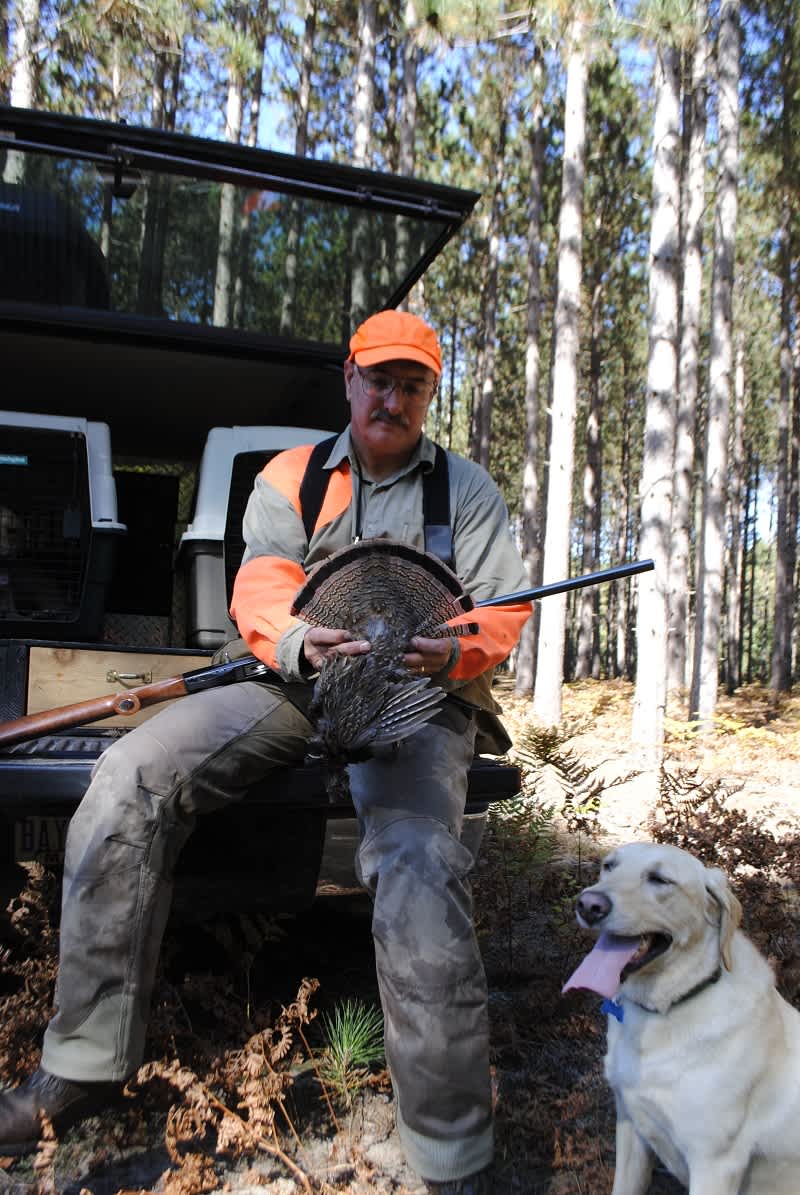Hunting Hard for Northern Michigan Ruffed Grouse
Bob Gwizdz 10.03.14

By now, most Michigan bird hunters understand that ruffed grouse populations are cyclical. They seem to run on a 10-year cycle (peak to peak) with the inevitable trough about halfway between the best of times.
Exactly why this is, no one knows. And right now, Michigan’s grouse population should be down toward the bottom of the cycle.
Yet when I spent a long morning with Fritz and Ric Heller and our mutual friend Paul Zeman in the woodlands near Kalkaska in the Northern Lower Peninsula last week, we moved better than 30 ruffs in about four hours on the ground. In a sport where three or four flushes an hour is generally pretty good, we doubled that. So what gives?
According to the Heller brothers, who are grouse-hunting machines, we’re still near the bottom of the cycle, but we’re enjoying the fruits of an outstanding nesting year. Their theory? The long, snowy winter left the lowlands so wet last spring that the birds were forced to seek higher ground during nesting season, so the young-of-the-year birds were less subject to mortality during heavy spring rains.
“I think this is one of those years when you get a lot of rebound from a down year,” said Fritz, a 37-year-old hotelier. “There aren’t birds in every spot. You can go five miles in either direction from where you found birds and not find any.
“The birds are not in poor cover.”
Our first foray into the woods that morning produced 10 flushes, but nothing in the bag, which is not all that unusual for most hunters (though it is for the Hellers) when they’re in cover as thick as gravy and the tree are all still fully leafed. What was unusual is we took a 75-minute tour; the Hellers typically make short (say, 20- to 30-minute) hunts, concentrating on the optimal cover—the spot within a spot. This time, however, they got a little off-track and spent a fair bit of time working their way through some poor habitat trying to get back on course.
“We’re not to the time of the fall shuffle yet when you find birds in fringe cover,” said 31-year-old Ric. “The broods aren’t totally broken up yet.”
Indeed, our flushes all occurred at the beginning or end of the jaunt (when we were in the good stuff) and were often of the multiple-bird variety.

Our second trip, much shorter in duration, yielded about the same results in terms of flushes and bagged birds. So halfway through the morning, we’d flushed 20 or more grouse and had nothing to show for it.
“I only had one good look and your wife will thank me for not shooting,” Fritz said. True enough, a bird flew right at me while I was tangled up in briars and stepping over a deadfall, and though I dispatched a prayer at it as it departed, it went unanswered.
We were hunting especially snarly stuff—tag alders adjoining head-high (on me) ferns. We were hunting along creek bottoms for a good reason: the heat.
“When the weather’s like this you have to go to your rivers and creeks,” Ric said. “You’ve got to get your dogs in the water; keep ‘em cool, keep ‘em wet. Think about how much better they can smell things when they’re cool.”
Both brothers brought three Labs (they rotated them among covers) and Zeman brought this Lab, too. We had plenty of dog power.
Our third hunt brought the first bird to bag; Rick downed an adult male as we worked through a long, low-lying autumn olive thicket.
“You’re more successful when the birds are on the food,” he noted. “All their awareness is on the food.”
That’s one reason why a lot of grouse hunters don’t worry about getting started first thing in the morning, to give birds time to get and about. We’d started early because the weatherman was forecasting Texas-like conditions.
Our next hunt, through a narrow mixed dogwood/alder stand, yielded birds to both Ric and Zeman. Things had improved.
“This is the first time this season we haven’t spent the majority of our time in aspen,” Fritz said. “We’ve been finding the majority of our bird in classic aspen—eight to 15 years old—especially if it’s got a beech or oak component to it. We’re not going in there today because of the heat. But given the numbers of acorns and beech nuts we’ve been seeing, I think in a couple of weeks you’d better be in there.”
It was nearly 80 degrees when we made our final foray through an autumn olive thicket (where the shrubs were so heavy with fruit they were bent over) adjoining some young popples. Ric killed his third bird. I got one decent look, but whiffed on it. That was all.

“Today’s the first day I hunted this year I didn’t kill a bird,” Fritz said.
That’s a rare occurrence.
Both Hellers are optimistic that they have a good season ahead of them.
“If we moved that many birds in this cover in mid-October, we’d have killed 10 of them,” Fritz said. “Last year, the first half of the season was awful and the second half was great. So this year, who knows?”
Indeed, who does? That’s what keeps us coming back, isn’t it?
For more information on Michigan hunting go to michigan.org. Click here to purchase a Michigan hunting license online.
This article was produced in partnership with Pure Michigan.

